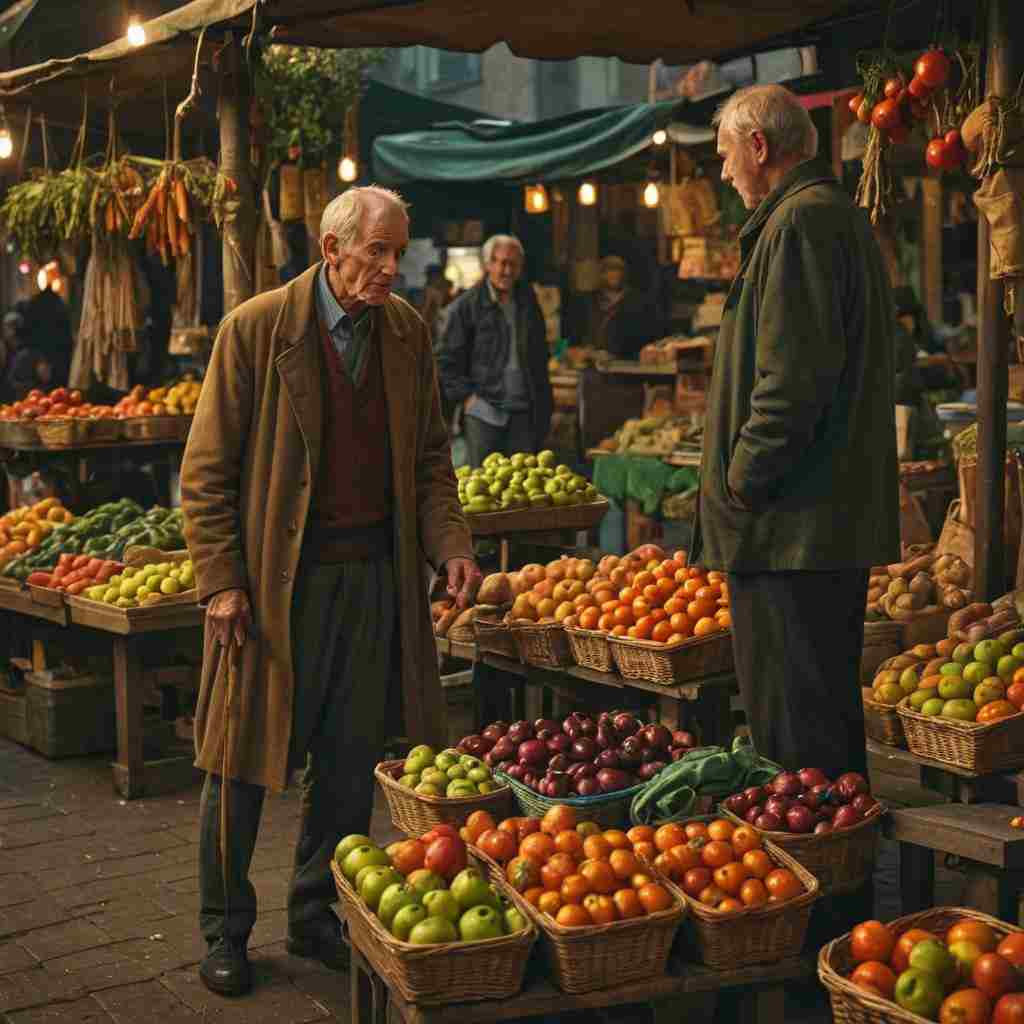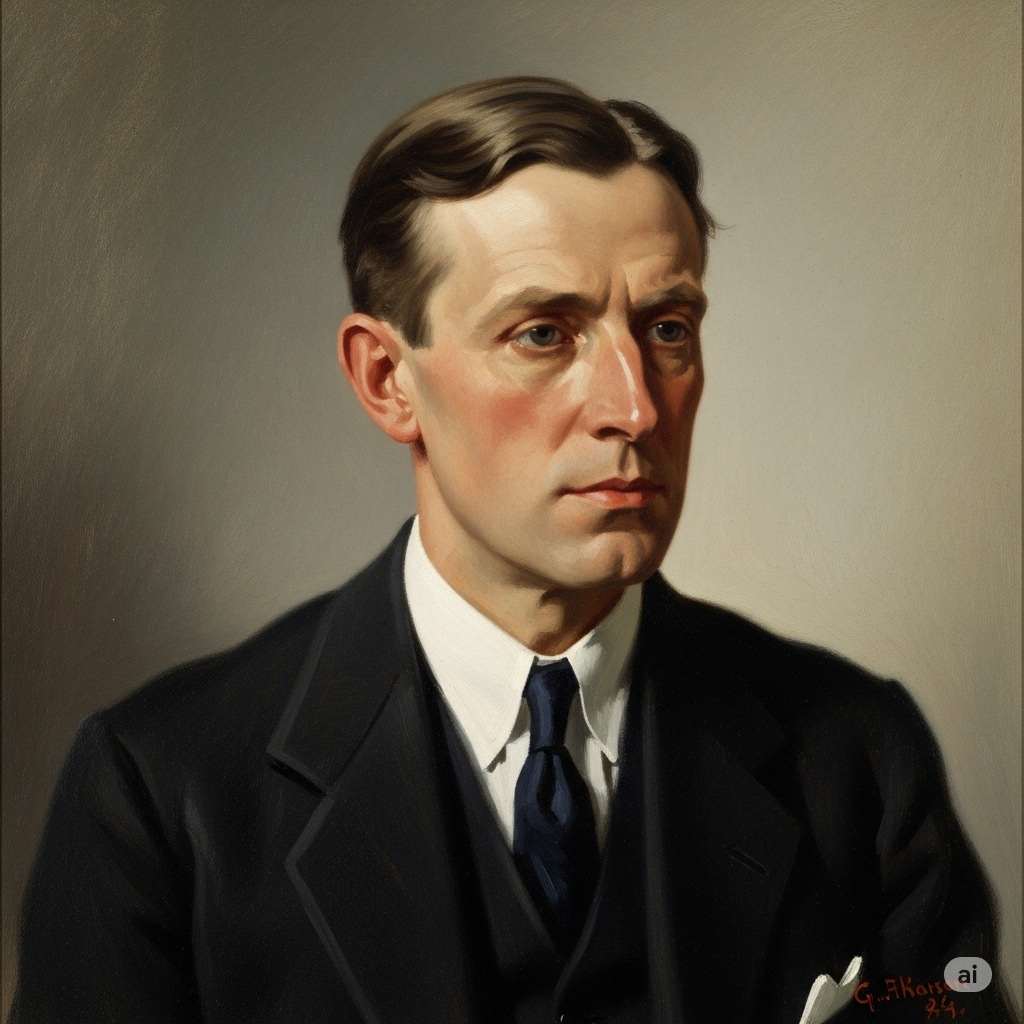Sight
Wilfrid Wilson Gibson
1878 to 1962

By the lamplit stall I loitered, feasting my eyes
On colours ripe and rich for the heart's desire—
Tomatoes, redder than Krakatoa's fire,
Oranges like old sunsets over Tyre,
And apples golden-green as the glades of Paradise.
And as I lingered, lost in divine delight,
My heart thanked God for the goodly gift of sight
And all youth's lively senses keen and quick...
When suddenly, behind me in the night,
I heard the tapping of a blind man's stick.
Wilfrid Wilson Gibson's Sight
Introduction
Wilfrid Wilson Gibson's poem "Sight" presents a vivid exploration of sensory experience and the profound impact of visual perception on human consciousness. Through its rich imagery and poignant conclusion, the poem invites readers to contemplate the often overlooked privilege of sight and the stark contrast between those who possess it and those who do not. This analysis will delve into the intricate layers of Gibson's work, examining its structure, language, and thematic elements to uncover the deeper meanings and implications woven throughout the text.
Structural Analysis
The poem consists of ten lines, structured as a single stanza with a rhyme scheme of ABBBACCAAC. This unique pattern creates a sense of cohesion while allowing for subtle shifts in tone and emphasis. The use of iambic pentameter, with occasional variations, lends a rhythmic quality to the verse that mimics the narrator's meandering thoughts and observations.
The poem's structure can be divided into two distinct parts: the first seven lines, which describe the narrator's visual feast, and the final three lines, which introduce the blind man and provide a stark contrast to the preceding imagery. This division serves to heighten the impact of the poem's conclusion and underscores the thematic tension between sight and blindness.
Imagery and Sensory Experience
Gibson's use of imagery in "Sight" is particularly striking, employing a rich palette of colors and historical allusions to create a sensory tapestry that engages the reader's imagination. The description of the "lamplit stall" immediately sets the scene, evoking a nocturnal marketplace filled with vibrant produce.
The poet's choice of similes and metaphors is both evocative and thought-provoking. The tomatoes, "redder than Krakatoa's fire," not only convey their intense color but also suggest a sense of danger and explosive potential. This reference to the infamous 1883 volcanic eruption adds a layer of historical and geological context to the seemingly mundane act of observing fruit.
Similarly, the oranges compared to "old sunsets over Tyre" transport the reader to the ancient Phoenician city, known for its purple dye and maritime trade. This allusion infuses the simple fruit with a sense of exoticism and historical significance, elevating the everyday to the realm of the extraordinary.
The "apples golden-green as the glades of Paradise" complete this triad of fruit imagery, invoking biblical connotations of the Garden of Eden. This reference not only adds to the visual splendor of the scene but also subtly introduces themes of temptation, knowledge, and the human condition.
Thematic Exploration
At its core, "Sight" is a meditation on the gift of vision and the often unacknowledged privilege it represents. The narrator's "divine delight" in observing the colorful produce serves as a metaphor for the broader joys and experiences made possible through sight. The phrase "my heart thanked God for the goodly gift of sight" explicitly frames vision as a divine blessing, emphasizing its profound importance to the narrator's experience of the world.
The poem also touches on the theme of youth and vitality, with the reference to "all youth's lively senses keen and quick." This line suggests that the ability to fully appreciate the visual world is not only a function of sight itself but also of youthful energy and enthusiasm. It implies a connection between sensory acuity and the vibrancy of youth, hinting at the potential diminishment of these faculties with age.
However, the true power of the poem lies in its abrupt shift in the final three lines. The introduction of the blind man, signaled by the sound of his tapping stick, serves as a stark reminder of the fragility and contingency of sight. This sudden juxtaposition forces the reader to confront the reality of those who lack this "goodly gift" and to reconsider the narrator's earlier expressions of gratitude and joy.
Literary Devices and Technique
Gibson employs several literary devices to enhance the impact of his poem. The use of alliteration, such as "feasting my eyes" and "divine delight," creates a musical quality that reinforces the sensory richness of the described scene. The repetition of "my heart" in lines 2 and 7 creates a circular structure that emphasizes the emotional core of the narrator's experience.
The poet's choice of verb tenses is also significant. The use of past tense throughout most of the poem (e.g., "I loitered," "my heart thanked") establishes a reflective tone, suggesting that the narrator is recounting a past experience. However, the shift to the present tense in the final line ("I heard") brings the reader abruptly into the immediate moment, heightening the impact of the blind man's appearance.
Cultural and Historical Context
To fully appreciate "Sight," it is important to consider its cultural and historical context. Gibson, writing in the early 20th century, was part of a literary movement that sought to bring attention to the lives and experiences of ordinary people. His focus on a simple market stall and the sudden intrusion of disability into this everyday scene reflects this broader artistic trend.
Moreover, the poem's emphasis on the value of sight takes on additional significance when considered in the context of the First World War, during which many soldiers suffered visual impairments due to combat injuries. While "Sight" does not explicitly reference war, its celebration of vision and acknowledgment of its absence would have resonated powerfully with readers of the time.
Philosophical Implications
Beyond its immediate themes, "Sight" invites deeper philosophical reflection on the nature of perception, consciousness, and human experience. The narrator's intense focus on visual stimuli raises questions about the relationship between sensory input and subjective experience. How much of our understanding of the world is shaped by what we can see? How do those without sight construct their reality?
The poem also touches on the concept of mindfulness and present-moment awareness. The narrator's deep appreciation of the colorful produce suggests a state of heightened consciousness, a temporary transcendence of everyday concerns. This state of blissful absorption is then disrupted by the reminder of the blind man's existence, forcing a reconsideration of the narrator's own privileged perspective.
Conclusion
Wilfrid Wilson Gibson's "Sight" is a masterful exploration of visual perception, gratitude, and the sudden shifts in perspective that can alter our understanding of the world. Through its vivid imagery, carefully crafted structure, and powerful conclusion, the poem encourages readers to reflect on the gift of sight and the diverse ways in which humans experience reality.
The work's enduring relevance lies in its ability to prompt self-reflection and empathy. By juxtaposing the narrator's visual feast with the stark reality of the blind man's experience, Gibson challenges us to consider our own sensory privileges and the often-overlooked challenges faced by those with different abilities.
Ultimately, "Sight" serves as a poignant reminder of the beauty and fragility of human perception. It invites us to approach the world with renewed appreciation for the sensory experiences we often take for granted, while also cultivating empathy and understanding for those whose experiences differ from our own. In doing so, Gibson's poem transcends its specific context to speak to universal themes of human consciousness, compassion, and the complex interplay between perception and reality.
This text was generated by AI and is for reference only. Learn more
Want to join the discussion? Reopen or create a unique username to comment. No personal details required!



Comments
No comments yet. Be the first to comment!